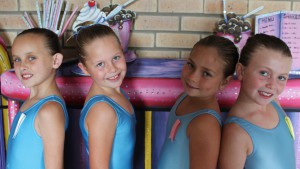Dance Teaching Tip 1:
With older children it is sometimes necessary to limit your demonstration or participation in the actual moving/dancing portions of class.
Young children, however, take all of their cues from you.
If you are asking them to pretend they are in a dark forest as they creep around the room, then you must be in that forest with them at least part of the time.
If you want them to perform with 100 percent of their energy, then you have to give 150 percent.
Modeling behavior is also important for showing children how to behave. Ask the students what is the proper way to sit or stand while waiting on their spot or number, then show them, and then have them practice it with you.
Dance Teaching Tip 2:
Young kids enrolled in a dance class are there to have fun. It is not yet truly satisfying to “work hard” at something even if they think it will please you.
If it doesn’t feel like playing, they’re far more likely to be inattentive.
Therefore, it is imperative that your energy level be high throughout the class, that you vary the tone of your voice, and that you aren’t afraid to be a bit goofy or over-the-top. You should be the most interesting thing in the room!
Bonus tip on vocal volume: I sometimes like to whisper when students are getting too noisy because it adds an element of surprise and because they have to quiet down to hear me.
Dance Teaching Tip 3:
The freedom to choose is empowering, particularly for children who are learning to become independent in their thoughts and decisions.
Try to include a chance for your dancers to make a choice at least once in each lesson.
However, be careful about offering unlimited possibilities. Children do best when they have an “either/or” alternative. This can be as simple as occasionally allowing children to choose if they’d like a blue spot or a red spot to stand upon (just make sure when offering these types of choices, you have enough of each so that no child gets “stuck” with something).
Every so often allow the class to vote for doing échappé or balancé for this lesson, practicing the other next week. You can also offer opportunities for children to make decisions in their movement. For instance they may choose between dancing sharply or smoothly (quickly/slowly, happily/sadly) around the room. They may choose to make a round shape or an angled shape (balanced/off-balanced, big/small) when they finish their exercise across the floor.
In fact, this ability to choose is what makes creative dance a powerful introduction to movement and dance for children (and, in fact, all people).
Dance Teaching Tip 4:
A chronically misbehaving child can be like a little thorn in your side. If you’re familiar with the advice to keep your enemies closer than your friends, this tip is similar.
Instead of constantly reprimanding the child, enlist his/her help in some way. Ask her to be your helper when handing out props, or recruit him to make the check marks in the attendance roster. Sometimes your faith in the student as you offer them this responsibility is all the incentive they need to behave better.
If you can identify the portions of class which are most difficult for this student (during recital practice, across the floor, etc.), these may be your best opportunities for recruitment.
Dance Teaching Tip 5:
Children have memories like elephants and never forget when you promise them something, so make it a rule of thumb never to promise them anything. I promise you, I have fallen into this trap many times.
For example, if they fight who is to go at the front of the line, and you don’t have enough time to let them all have a chance, rather say another time instead of next time. Let them know that they could also lose their place if their behaviour is bad.


This is very good! I like all the advice. The author really understands children psychology.
Yes, I agree. When working with children, you have to have endless energy or they quickly become disinterested too. The teacher has to lead and participate in all the fun. And it all has to be natural and authentic. Otherwise the children can sense the catch immediately.
And I agree about naughty children, too. I wouldn’t even say they’re naughty. You just have to try to find activities to keep them interested and engaged.